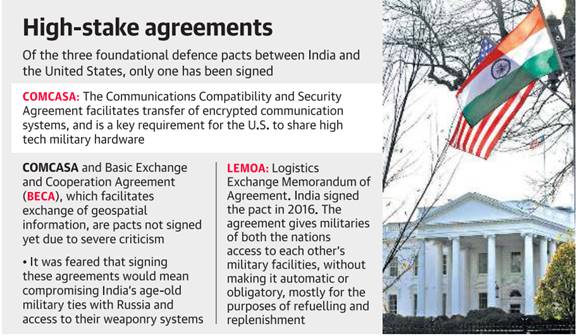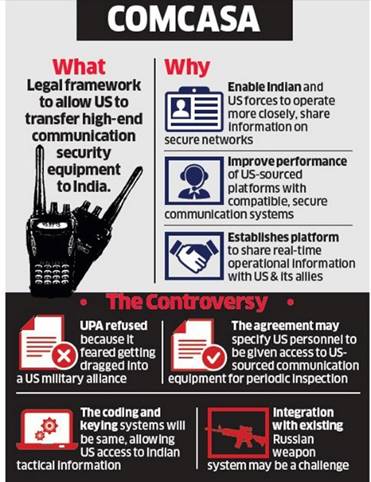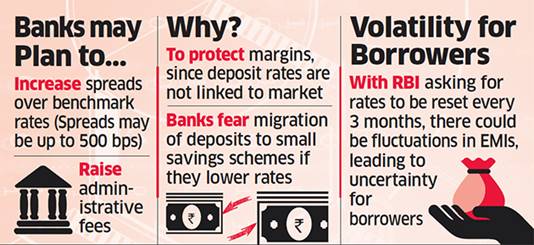



Explained: What is US-India Defence Technology and Trade Initiative
The ninth India-US Defence Technologies and Trade Initiative (DTTI) group meeting is scheduled to happen in New Delhi next week. A statement issued by the US Department of Defence said that the value of bilateral defence trade between the two countries is estimated to reach USD 18 billion later this year.
- In August 2018, the US granted to India the designation of Strategic Trade Authority Tier 1 or STA-1.
- It allows US companies to export a greater range of dual-use and high technology items to India under streamlined processes.
- This authorisation is the equivalent of NATO allying with Japan, South Korea and Australia.

- According to the Office of the Under Secretary of Defence for Acquisition and Sustainment, DTTI came about to expedite the scope of cooperation on defence technology that become narrow due to the presence of differing bureaucratic processes and legal requirements.
- DTTI is an initiative to provide “increased US senior level oversight and engagement to get beyond these obstacles.
- It is a flexible mechanism to make sure that senior leaders from both countries are engaged consistently to strengthen the opportunities in the field of defence.
- Its central aims include strengthening India’s defence industrial base, exploring new areas of technological development and expanding U.S.-India business ties.
- India has raised its caps on foreign direct investment in domestic defence firms (from 26 percent to 49 percent ownership stakes).
- India made slight modifications to its defence offsets policy to induce foreign investment in the defence sector, allowing offset requirements to be met through investment in the civilian aerospace sector in addition to the defence sector.
- United States formally changed its export policy for India beginning in 2001 by lifting sanctions based on the determination that it was in the United States’ interest to facilitate the rise of a strong India.
- USA transitioned from a presumption of denial posture, a policy that effectively blocked exports of sensitive military or dual use technologies to India without significant justification to a general policy of approval for exports of most military technologies to India (provided they are not to be used in nuclear, missile, chemical, or biological weapons programs).
- The United States’ 2016 designation of India as a major defence partner, a classification unique to New Delhi, is indicative of India’s elevated status in U.S. export considerations.

- American firms have successfully sold several high-end platforms to India since 2008, including P-8 maritime patrol aircraft, C-130 and C-17 transport aircraft, M777 howitzers, and Apache and Chinook helicopters.
- While the U.S government has demonstrated its intent to sell sophisticated platforms and transfer technology to India, there are some technologies it will not share with any country so it can maintain its competitive edge. But, India prefers technology transfer.
- Washington’s willingness to share sensitive technology with a partner country depends upon whether the country’s government provides assurances the technology will be protected as per U.S. standards. New Delhi must conclude a governmental agreement with Washington regarding private sector security practices before U.S. private sector entities can engage Indian counterparts in the development or manufacture of sensitive technologies.
- The DPP deliberately favours the lowest-cost bid among submitted offers deemed compliant with DPP criteria. Using lowest cost as the determining factor in DPP decisions creates a disincentive to firms to offer more than the bare minimum technology required by India’s request for proposals simply because sophisticated technology tends to cost more.
- The Department of Defence, when running an acquisition contract competition, may select a vendor based on the best value to government, even if that vendor does not offer the lowest price.
For the first time in 37 years, the British Parliament convened on a Saturday so that Members of Parliament (MPs) could cast their votes on Prime Minister Boris Johnson’s Brexit deal that was scheduled to take United Kingdom out of the European Union (EU) by October 31.
- Lawmakers passed an amendment that has effectively delayed a vote on Brexit, until the House of Commons passes required legislation to execute it properly.
- Essentially, this meant that Johnson was legally obliged to request the EU under the Benn Act to extend the date the votes on Brexit will be cast.
- The Benn Act is formally called the European Union (Withdrawal) (No. 2 Act) 2019 and is an act of the UK Parliament, which legally mandates seeking an extension for the negotiating period under certain circumstances.
- The first public vote or a referendum on Brexit happened three years ago on June 23, 2016 when David Cameron was prime minister.
- About 52 per cent of the voters chose to leave the EU, while 48 per cent voted to stay.
- Originally, Brexit was scheduled to happen on March 29, 2019, two years after then Prime Minister Theresa May triggered Article 50.
- This article mentions the legal mechanism through which a member state can exit from the EU and was agreed upon by all member states of the EU under the Lisbon Treaty signed in 2009.
- Triggering Article 50 means the formal decision of the government of that member state to leave.
- Once a deal has been agreed upon between the UK and EU, it needs to be approved by the House of Commons, which has not happened till now.
- According to BBC, the main sticking point for many Conservative MPs and the Democratic Unionist Party (an ally of May’s government at the time) were the Irish backstops that govern the nature of the border between Northern Ireland (a part of UK) and the Republic of Ireland.
- At present, no hard border exists between the two areas and goods and people can pass without any regulatory checks. The backstop therefore, refers to a legal-binding tool to make sure that post-Brexit, the Irish border remains open.
- Post-Brexit, the EU wants to enforce its standard customs procedure.
- The EU won’t back a deal that is too lenient on the borders and the DUP won’t approve a deal that enforces a hard border.
- According to the New deal presented by Boris Johnson, while Northern Ireland would continue to be a part of the UK, it would also be governed by some European regulations complete with a customs check between the UK and Northern Ireland.
- If extended it will also delay the European Parliament’s agreement to the deal, which was scheduled for next week.
- The European parliament can ratify the deal only after it has been passed by the House of Commons.
- Without any decision on Brexit in sight, the outcomes are multiple, it is possible that the UK takes a no-deal exit from the EU, which means if and when Brexit happens, there would be no terms determining the relationship between UK and EU affecting trade, transport and border mechanisms.
- Secondly, it is possible that a second public vote on whether to leave the EU at all is called for.
- Thirdly, Johnson could call for general elections to restore his party’s majority in the House of Commons.
Since February, the Reserve Bank of India (RBI) has aggressively cut the repo rate. This is the interest rate that the RBI charges the banks when it lends them money.
- By cutting the repo rate, the RBI has been sending a signal to the rest of the banking system that the lending rates in the system – the interest rates that banks charge from you and me when we take a loan – should come down.
- This process of repo rate cuts leading to interest rate cuts across the banking system is called “monetary policy transmission”.
- The trouble is, in India, this process is rather inefficient.
- In essence, while the RBI has cut its lending rate to the banks by 135 basis points (or 1.35 percentage points) in the nine months since February, the interest rates being charged to the common consumer this Diwali have come down by only about 40-odd basis points.
Projections of GDP growth rate have come down from roughly 7.2%-7.5% in February to 5.8%-6.0%. There are two major reasons for it.
- The main issue is that people are not consuming at a high enough rate. If banks reduce their lending rates, they would also have to reduce their deposit rates. This, in turn, will incentivise people to save less and spend more.
- The other problem in the economy at present is that businesses are not investing in existing or new facilities. One of the reason is high interest rate charged on loans.
RBI’s decision to cut repo rates was a justified move, especially since overall retail inflation has been well within the RBI’s comfort zone of 4%.
- Repo rates have little impact on a bank’s overall cost of funds, and reducing lending rates just because the repo has been cut is not feasible for banks.
- To attract deposits, banks pay a high deposit rate. Such deposits make up almost 80% of all banks’ funds from which they then lend to borrowers. Unless banks reduce their deposit rates, they will not be able to reduce their lending rates.
- If a bank were to reduce its deposit rates, depositors would shift to a rival bank that pays better interest rates.
- Park more and more of their savings in small saving instruments such as public provident fund, Sukanya Samriddhi Yojana etc that pay much higher interest rates.
- 65% of total deposits are “term” deposits (fixed for a certain duration) and take, on an average, up to two years to get repriced at fresh rates.
Therefore, banks generally go slow on reducing the interest rates on advances as deposits take longer to get repriced.”
- The banks cannot link their lending to the repo rate because repo doesn’t determine their cost of funds.
- For a repo-linked regime to work, the whole banking system would have to shift to that – in other words, along with banks’ lending rates, their deposit rates too must go up and down with the repo.

- Diaspora has kept their languages alive in your daily lives, be it Punjabi, Sindhi, Tamil, Malayalam, Hindi or Gujarati.
- Yoga is very popular in the Philippines and ayurveda is also gaining ground.
- They continue to believe in Indian values of Vashudhev Kutumbkam.
- They have created places of worship mainly temples and Gurudwaras.
- Old artifacts have been unearthed in the Philippines that are distinctly of Indian influence.
- Laguna Copper Plate inscription, the oldest artifact discovered in the Philippines, is written in Kavi which possibly derived from the Pallava script.
- A golden statue of Goddess Tara has also been found in Agusan.
- India has already relaxed rules and regulations for you to obtain OCI cards.
- India has made consular service delivery people-sensitive and people-friendly.
- India is dutifully reaching out to those in need, through social media platforms and through community networks.
- India is also offering seats in educational institutions for diaspora children to study in India.
- India is running “Know India Program” for the youth and for the elderly, to connect you deeper to your roots and to your culture.
Source: PIB

© 2025 iasgyan. All right reserved